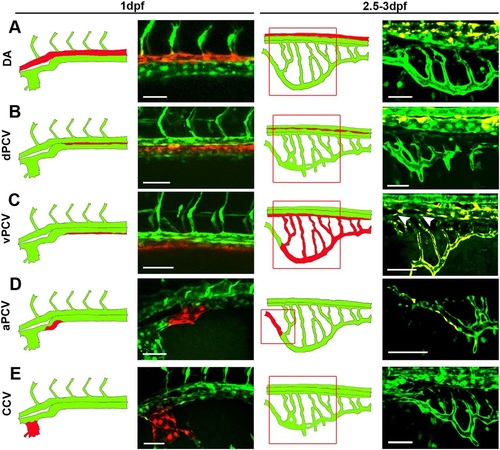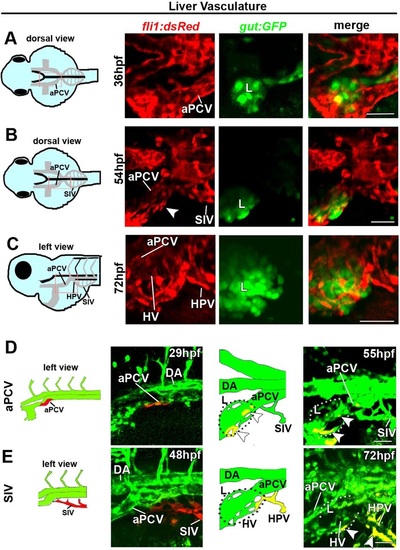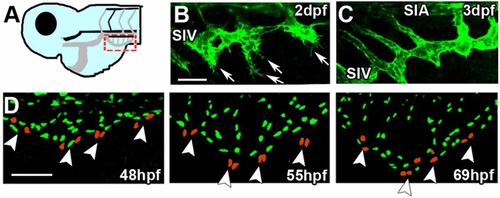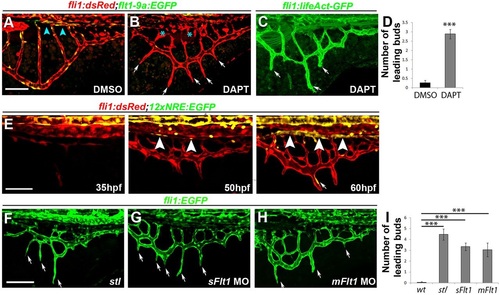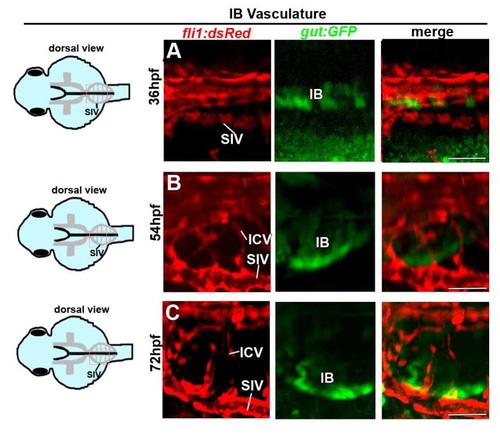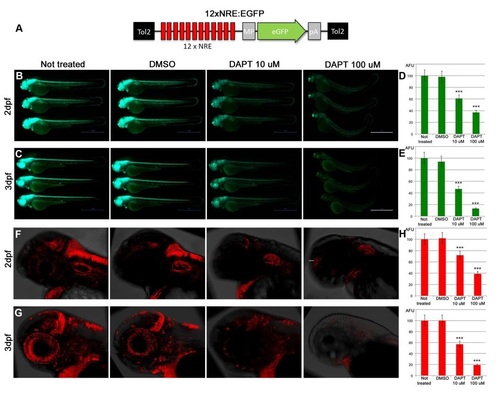- Title
-
Venous-derived angioblasts generate organ-specific vessels during embryonic development
- Authors
- Hen, G., Nicenboim, J., Mayseless, O., Asaf, L., Shin, M., Busolin, G., Hofi, R., Almog, G., Tiso, N., Lawson, N.D., Yaniv, K.
- Source
- Full text @ Development
|
Arterial-venous identity of the subintestinal vessels. (A) Directionality of blood flow in the subintestinal plexus, as determined in Tg(fli1:EGFP;gata1a:dsRed) embryo at 3.5dpf. White arrows indicate the direction of flow in the DA, PCV, SIA, SIV and ICVs. (B) Colocalization (yellow) of fli1:EGFP (green) and lyve1:dsRed fluorescence in venous ECs of the PCV, ICVs, TD and SIV of 4dpf Tg(fli1:EGFP;lyve1:dsRed) double transgenic embryos. The DA and SIA show no lyve1:dsRed expression. (C) Colocalization (yellow) of fli1:dsRed and flt1_9a (green) in arterial ECs of the DA and SIA of 4dpf Tg(flt1_9a_cfos:GFP;fli1:dsRed) double transgenic embryos. DA, dorsal aorta; ICVs, interconnecting vessels; PCV, posterior cardinal vein; SIA, supraintestinal artery; SIV, subintestinal vein; TD, thoracic duct. Scale bars: 50Ám. |
|
PCV cells give rise to all components of the subintestinal plexus. (A-E) Photoswitching of selected ECs was performed at 1dpf in Tg(fli1:gal4;uas:kaede) embryos, and vessels were scored for the presence of red-labeled ECs at 2.5-3dpf. Schematic illustrations of the corresponding confocal images are shown to the left. No photoconverted red cells were detected in the subintestinal plexus following photoswitching of the DA (A), dPCV (B) and CCV (E). Photoswitching of the vPCV (C) rendered red-labeled ECs in all components of the subintestinal plexus, including the SIA (arrowheads), whereas photoconverted ECs from the aPCV (D) were found exclusively in the rostral most part of the SIV. aPCV, anterior PCV; CCV, common cardinal vein; dPCV, dorsal PCV; vPCV, ventral PCV; for other abbreviations see legend to Fig. 1. Yellow channel denotes colocalization of green and red fluorescence. Scale bars: 50Ám. nDA=24, ndPCV=10, nvPCV=16, naPCV=5, nCCV=11. |
|
The left subintestinal vein and aPCV give rise to the liver vasculature. (A-C) Confocal images of Tg(gut:GFP;fli1:dsRed) double transgenic embryos at 36-72hpf highlighting the vasculature (red) and the liver (L, green). (A) The aPCV on the left side of the embryo is found adjacent to the liver at 36hpf. (B,C) ECs surround the liver by 54hpf (B, arrowhead) and form the HVs by 72hpf (C). The SIV drains into the liver via the HPV (C). (D,E) Photoswitching of ECs in the left branch of the aPCV (D) or the left SIV (E) was performed at 29hpf in Tg(fli1:gal4;uas:kaede) embryos. (D) Red-labeled ECs from the left aPCV contribute to the liver vasculature (55hpf, arrowheads). (E) Photoswitching of the left SIV at 48hpf rendered red-labeled ECs in the HVs and the HPV (E, 72hpf, arrowheads). aPCV, anterior PCV; HPV, hepatic portal vein; HV, hepatic vessels; L, liver; for other abbreviations see legend to Fig. 1. Yellow channel denotes colocalization of green and red fluorescence. Scale bars, 50Ám. naPCV=4, nSIV=5. |
|
The right subintestinal vein and aPCV give rise to the pancreatic vasculature. (A-C) Confocal images of Tg(-1.0ins:EGFP;fli1:dsRed) embryos at 36-62hpf highlighting the vasculature and the endocrine pancreas (P, green). (A) insulin:EGFP+ cells are detected between the two branches of the aPCV at 36hpf. (B,C) Gradual shift of insulin:EGFP+ cells towards the right side of the midline. The most cranial ICV on the right side of the plexus (C) sends branches towards the nascent pancreas and forms pancreatic vessels (PV). (D,E) Photoswitching of ECs in the right branch of the aPCV at 29hpf (D) or in the right SIV at 48hpf (E) was performed in Tg(fli1:gal4;uas:kaede;-1.0ins:EGFP) embryos. (D) Red-labeled ECs from the right aPCV contribute to the pancreatic vessels (PV) (55hpf, arrowhead). (E) Photoswitching of the right SIV at 48hpf rendered red-labeled ECs in the pancreatic vessels (PV) (72hpf, arrowheads). aPCV, anterior PCV; P, pancreas; PV, pancreatic vessels; for other abbreviations see legend to Fig. 1. Yellow channel denotes colocalization of green and red fluorescence. Scale bars, 50Ám. naPCV=8, nSIV=11. |
|
Formation of the subintestinal plexus involves different mechanisms of EC migration. (A) Snapshots from a time-lapse sequence of a Tg(fli1:dsRed) embryo, showing individual sprouts arising from the vPCV (32hpf, white arrowheads), which quickly anastomose and fuse with a caudal projection of the aPCV (red arrowhead) to generate the primary SIV. Sprouts arising along the primary SIV elongate ventrally and fuse to generate the mature SIV (35-41hpf, white arrowheads). Concomitantly, ECs from the SIV migrate dorsally to generate the SIA (39-41hpf, light-blue arrowheads). The mature SIV migrates ventrally through collective migration guided by leading buds (56hpf, white arrows), while fusion of angiogenic sprouts originating in the primary SIV generates vascular loops (56hpf, green asterisks). Retraction of the leading buds, along with pruning of the cross-branches forming the vascular loops, render the stereotypical basket shape (78hpf) that engulfs the intestinal bulb (IB). (B) Snapshots from a time-lapse sequence of a Tg(fli1:dsRed;fli1:nGFP) embryo showing the migration route taken by vPCV angioblasts. A single angioblast (light blue) initially residing in the vPCV (34.75hpf, white arrowhead) sprouts ventrally (36hpf, white arrowhead) and incorporates into the primary SIV (36.25-51.5hpf, white arrowhead). Later on, the same cell migrates dorsally (55.25hpf, light blue arrowhead), eventually becoming incorporated into the SIA (59.75hpf, light blue arrowhead). (C) Schematic illustration depicting the different steps involved in formation of the subintestinal plexus: ventral sprouting and ventral migration (black arrows); cells ?lagging back? followed by dorsal migration (purple arrows); vascular loops (green asterisks); and vessel pruning (black arrowhead). Scale bars: 50Ám. |
|
Establishment of the SIV involves leading bud-guided collective migration of ECs. (A) Dashed red box in the diagram shows approximate location of regions imaged in B-D. (B) Actin-rich filopodia (arrows) are detected at the SIV migration front in Tg(Lifeact:GFP) embryos at 2dpf. (C) As the plexus reaches its stereotypical basket shape at 3dpf, all filopodia retract. (D) Distribution of EC nuclei in Tg(fli1:nGFP) embryos demonstrates that leading buds consist of paired ECs (48-55hpf, arrowheads), rather than of a single tip cell. Towards the end of the process, leading buds retract and are incorporated into the SIV (69hpf, arrowheads). Scale bars: 50Ám. |
|
Notch activity is required for final remodeling of the subintestinal plexus but is dispensable for its initial development. (A-D) The subintestinal plexus of 72hpf Tg(fli1:dsRed;flt1_9a_cFos:GFP) embryos treated with DAPT between 24 and 72hpf shows the presence of ectopic leading buds (B,C, arrows; D), malformed SIA (B, asterisks) and active filopodia along the SIV (C, arrows). nDMSO=29; nDAPT=36. ***P<0.001. (E) Spatiotemporal characterization of Notch signaling activation during development of the subintestinal plexus, as detected in Tg(fli1:dsRed;12xNRE:EGFP) double transgenic embryos. EGFP is detected in the SIA starting at 50hpf (arrowheads) and in the leading buds of 60hpf embryos (arrow). (F-I) Downregulation of flt1 results in ectopic leading buds along the SIV of stl mutants (F, arrows), sFlt1 (G, arrows) and mFlt1 (H, arrows) morphants, quantified in I. Yellow channel denotes colocalization of green and red fluorescence. Scale bars: 50Ám. nWT=16, nstl=13, nmFlt=27, nsFlt=18. ***P<0.001. Error bars represent s.e.m. EXPRESSION / LABELING:
PHENOTYPE:
|
|
Molecular mechanisms controlling formation of the subintestinal plexus. (A-C) Subintestinal vessels form normally in vegfc (A,C) and flt4 (B,C) mutants. nvegfc=19; nFlt4=5. (D) Activation of BMP signaling is detected in the PCV (28hpf, arrowheads) and SIV (36-72hpf, arrowheads) of Tg(2xID1BRE:nlsmCherry) embryos. (E-G) Heat shock induction of noggin3 expression in Tg(fli1:EGFP; lyve1:dsRed; hsp70l:noggin3) embryos inhibits ventral migration of the plexus, as manifested by reduced basket length when compared with Tg(fli1:EGFP;lyve1:dsRed) (WT) embryos (E,F). The SIA forms normally (E, arrows). Cells in the SIV of noggin3-overexpressing embryos fail to upregulate the lymph-venous marker lyve1 (E,G). (H,I) The vPCV of Tg(fli1:gal4;uas:kaede) (WT) and Tg(fli1:gal4;uas:kaede;hsp70l:noggin3) double transgenic embryos was photoconverted at 30hpf (H). At 55hpf, red/yellow-labeled ECs were detected in the SIV of both WT and hsp70l:noggin3-overexpressing embryos (I). (J,K) Impaired Vegf signaling results in reduced number of ICVs in kdrl and plcg mutants (J,K). The SIA is absent in plcg mutants (J, asterisks).Yellow channel denotes colocalization of green and red fluorescence. Scale bars: 50Ám. nvegfc=19; nFlt4=5; nnoggin3=11; nkdrl=13; nplcg=9. **P<0.01; ***P<0.001. Error bars represent s.e.m. EXPRESSION / LABELING:
PHENOTYPE:
|
|
Anatomical distribution of the gastrointestinal organs and their vasculature (A-C) Confocal images of Tg(gut:GFP;fli1:dsRed) (A,B) and Tg(-1.0ins:EGFP; fli1:dsRed) (C) embryos at 3-4 dpf. (A′-C′) Explanatory diagrams of the corresponding confocal images, depicting the relative position of veins (grey), arteries (black), and organs (green). (A′′-C′′) Digital sections (10-15Ám) performed at the approximate position indicated by the dashed line. (A-A′′) Hepatic vessels (HV) surround and penetrate the liver (L) by 4 dpf, and connect to the hepatic portal vein (HPV) and aPCV. (B-B′′) The SIV, SIA and ICVs vascularize the intestinal bulb (IB). (C-C′′) The first right ICV interconnects the right SIV with the SIA, and gives rise to vessels penetrating the pancreatic anlage. aPCV, anterior PCV; HPV, hepatic portal vein; HV, hepatic vessels; ICV, interconnecting vessels; SIV, subintestinal vein; IB, intestinal bulb; P, pancreas; PV, pancreatic vessels. Scale bars: 50Ám. |
|
The intestinal bulb develops in close contact to the subintestinal vessels (A-C) Confocal images of Tg(gut:GFP;fli1:dsRed) embryos at 36-72 hpf showing morphogenesis and growth of the intestinal bulb (IB) and its vasculature arising from the ICVs and SIV. ICV, interconnecting vessel; IB, intestinal bulb; SIV, subintestinal vein. Scale bars: 50Ám. |
|
Generation and validation of a 12xNRE:EGFP Notch signaling reporter (A) Schematic illustration of the 12xNRE Notch reporter, consisting of 12 Notch-responsive elements (12xNRE) and a rabbit β-globin minimal promoter (MP), followed by enhanced GFP (eGFP) and polyA (pA) tail, flanked by Tol2 elements. (B,C) Dose-response of Notch signaling in 12xNRE:EGFP embryos, following treatment with the Notch signaling inhibitor DAPT. (D,E) Quantification of EGFP intensity following treatments in B and C. Results are shown in arbitrary fluorescence units (AFU). n=6 per treatment. ***P<0.0001. (F,G) Fluorescent in situ hybridization for EGFP following DMSO or DAPT treatment. (H,I) Quantification of fluorescence detected following treatments in F and G. n=6 for each treatment. ***P<0.0001. Embryos were exposed to 10 or 100 ÁM DAPT, or DMSO, from 24 to 48 hpf (B,D) or from 24 to 72 hpf (C,E). Scale bars: 100Ám. |
|
Impaired Notch and Flt1 signaling does not affect venous-fate of the SIV Downregulation of flt1 in stl mutants or flt1 morphants resulted in lyve1:dsRed-positive (colocalization in yellow) ectopic leading buds along the SIV (arrows). Scale bars: 50 Ám. |


